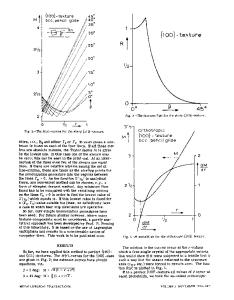Lamellar Interfaces and Their Contribution to Plastic Flow Anisotropy in TiAl-Based Alloys
- PDF / 1,893,862 Bytes
- 6 Pages / 420.48 x 639 pts Page_size
- 76 Downloads / 327 Views
LAMELLAR INTERFACES AND THEIR CONTRIBUTION TO PLASTIC FLOW ANISOTROPY IN TiAI-BASED ALLOYS.
Bimal K. Kad, AMES-041 1, University of California-San Diego, LaJolla, CA 92093. Peter M. Hazzledine, UES Inc. 4401 Dayton-Xenia Road, Dayton, OH 45432. and Hamish L. Fraser, 2041 College Road, Ohio State University, Columbus, OH 43210
ABSTRACT Lamellar Y(/02 TiAl deforms much more easily in the plane of the lamellae (soft mode) than across the lamellae (hard mode). This plastic anisotropy is caused by the soft mode being softer and the hard mode being harder than in monolithic TiAl. The suggested explanations are that the y phase is softened by interstitial gettering, that an extra soft mode exists because superdislocations can channel along interfaces and that the hard mode is dominated by the Hall-Petch effect. INTRODUCTION Two phase y-TiAl (Lo0 ) + ct 2 -Ti 3 Al (D0 19 ) alloys with fine scale (-l-21.m) lamellar microstructures exhibit a lower soft mode yield stress (1), increased strain to failure (2) and improved fracture toughness over their monolithic constituents. The beneficial effect of a small volume fraction (5-15%) of Ti 3AI and the subsequent lamellar morphology has been the subject of considerable debate in recent years (3). While the exact reason for this behavior is not well understood, two phase microstructures are characterized to have an abundance of 1/2
Data Loading...










